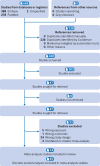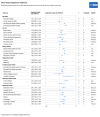Ultra-processed food exposure and adverse health outcomes: umbrella review of epidemiological meta-analyses
- PMID: 38418082
- PMCID: PMC10899807
- DOI: 10.1136/bmj-2023-077310
Ultra-processed food exposure and adverse health outcomes: umbrella review of epidemiological meta-analyses
Abstract
Objective: To evaluate the existing meta-analytic evidence of associations between exposure to ultra-processed foods, as defined by the Nova food classification system, and adverse health outcomes.
Design: Systematic umbrella review of existing meta-analyses.
Data sources: MEDLINE, PsycINFO, Embase, and the Cochrane Database of Systematic Reviews, as well as manual searches of reference lists from 2009 to June 2023.
Eligibility criteria for selecting studies: Systematic reviews and meta-analyses of cohort, case-control, and/or cross sectional study designs. To evaluate the credibility of evidence, pre-specified evidence classification criteria were applied, graded as convincing ("class I"), highly suggestive ("class II"), suggestive ("class III"), weak ("class IV"), or no evidence ("class V"). The quality of evidence was assessed using the GRADE (Grading of Recommendations, Assessment, Development, and Evaluations) framework, categorised as "high," "moderate," "low," or "very low" quality.
Results: The search identified 45 unique pooled analyses, including 13 dose-response associations and 32 non-dose-response associations (n=9 888 373). Overall, direct associations were found between exposure to ultra-processed foods and 32 (71%) health parameters spanning mortality, cancer, and mental, respiratory, cardiovascular, gastrointestinal, and metabolic health outcomes. Based on the pre-specified evidence classification criteria, convincing evidence (class I) supported direct associations between greater ultra-processed food exposure and higher risks of incident cardiovascular disease related mortality (risk ratio 1.50, 95% confidence interval 1.37 to 1.63; GRADE=very low) and type 2 diabetes (dose-response risk ratio 1.12, 1.11 to 1.13; moderate), as well as higher risks of prevalent anxiety outcomes (odds ratio 1.48, 1.37 to 1.59; low) and combined common mental disorder outcomes (odds ratio 1.53, 1.43 to 1.63; low). Highly suggestive (class II) evidence indicated that greater exposure to ultra-processed foods was directly associated with higher risks of incident all cause mortality (risk ratio 1.21, 1.15 to 1.27; low), heart disease related mortality (hazard ratio 1.66, 1.51 to 1.84; low), type 2 diabetes (odds ratio 1.40, 1.23 to 1.59; very low), and depressive outcomes (hazard ratio 1.22, 1.16 to 1.28; low), together with higher risks of prevalent adverse sleep related outcomes (odds ratio 1.41, 1.24 to 1.61; low), wheezing (risk ratio 1.40, 1.27 to 1.55; low), and obesity (odds ratio 1.55, 1.36 to 1.77; low). Of the remaining 34 pooled analyses, 21 were graded as suggestive or weak strength (class III-IV) and 13 were graded as no evidence (class V). Overall, using the GRADE framework, 22 pooled analyses were rated as low quality, with 19 rated as very low quality and four rated as moderate quality.
Conclusions: Greater exposure to ultra-processed food was associated with a higher risk of adverse health outcomes, especially cardiometabolic, common mental disorder, and mortality outcomes. These findings provide a rationale to develop and evaluate the effectiveness of using population based and public health measures to target and reduce dietary exposure to ultra-processed foods for improved human health. They also inform and provide support for urgent mechanistic research.
Systematic review registration: PROSPERO CRD42023412732.
© Author(s) (or their employer(s)) 2019. Re-use permitted under CC BY-NC. No commercial re-use. See rights and permissions. Published by BMJ.
Conflict of interest statement
Competing interests: All authors have completed the ICMJE uniform disclosure form at www.icmje.org/coi_disclosure.pdf and declare: MML, EG, DNA, AJM, SG, FNJ, AO, and WM are affiliated with the Food & Mood Centre, Deakin University, which has received research funding support from Be Fit Food, Bega Dairy and Drinks, and the a2 Milk Company and philanthropic research funding support from the Waterloo Foundation, Wilson Foundation, the JTM Foundation, the Serp Hills Foundation, the Roberts Family Foundation, and the Fernwood Foundation; MML is secretary for the Melbourne Branch Committee of the Nutrition Society of Australia (unpaid) and has received travel funding support from the International Society for Nutritional Psychiatry Research, the Nutrition Society of Australia, the Australasian Society of Lifestyle Medicine, and the Gut Brain Congress and is an associate investigator for the MicroFit Study, an investigator-led randomised controlled trial exploring the effect of diets with varying levels of industrial processing on gut microbiome composition and partially funded by Be Fit Food (payment received by the Food and Mood Centre, Deakin University); AMJ is secretary for the International Society for Nutritional Psychiatry Research (unpaid) and an associate investigator for the MicroFit Study; SG is affiliated with Deakin University, which has received grant funding support from a National Health and Medical Research Council Synergy Grant (#GNT1182301) and Medical Research Future Fund Cardiovascular Health Mission (#MRF2022907), is affiliated with Monash University, which has received grant funding support from Medical Research Future Fund Consumer-led research (#MRF2022907), is secretary for the Australian Cardiovascular Health and Rehabilitation Association—Victoria and Tasmania—(unpaid), and has received travel funding support from the Institute for Mental and Physical Health and Clinical Translation and SOLVE-CHD (solving the long-standing evidence-practice gap associated with cardiac rehabilitation and secondary prevention of coronary heart disease); PB has received funding from an Australian Research Council Future Fellowship award (project number #FT220100690) and from Bloomberg Philanthropies; ML is affiliated with the Institute for Physical Activity and Nutrition, School of Exercise and Nutrition Sciences, Deakin University, which has received grant funding support from the Australian Research Council (#DP190101323), and has received royalties or license funding from Allen and Unwin (Public Health Nutrition: from Principles to Practice) and Routledge, Taylor and Francis Group (Healthy and Sustainable Food Systems) and consultation and remuneration funding support from WHO and Food Standards Australia New Zealand (in his role as a board member); CMR is affiliated with Johns Hopkins Bloomberg School of Public Health and Johns Hopkins University, which have received grant funding support from the National Heart, Lung, and Blood Institute, Bloomberg American Health Initiative, and the National Institute of Diabetes and Digestive and Kidney Diseases, was chair of the Data and Safety Monitoring Boards for the SUPER Trial: Effect of Dietary Sodium Reduction in Kidney Disease Patients with Albuminuria and the ADEPT Trial: A Clinical Trial of Low-Carbohydrate Dietary Pattern on Glycemic Outcomes, was on the Editorial Board of Diabetes Care (unpaid), was the immediate past chair for the Early Career Committee of the Council on Lifestyle and Cardiometabolic Health, American Heart Association (unpaid), and the Nutritional Epidemiology Research Interest Section of the American Society for Nutrition (unpaid), and has received funding support as an associate editor of Diabetes Care and editorial fellow of the Journal of the American Society of Nephrology; FNJ has received fellowship funding support from the National Health and Medical Research Council (#1194982) and payment or honorariums for lectures, presentations, speakers bureaus, manuscript writing, or educational events from the Malaysian Society of Gastroenterology and Hepatology, JNPN Congress, American Nutrition Association, Personalised Nutrition Summit, and American Academy of Craniofacial Pain, is a Scientific Advisory Board member of Dauten Family Centre for Bipolar Treatment Innovation (unpaid) and Zoe Nutrition (unpaid), has written two books for commercial publication on the topic of nutritional psychiatry and gut health, and is the principal investigator for the MicroFit Study; AO has received fellowship funding support from the National Health and Medical Research Council (#2009295) and is affiliated with Deakin University, which has received grant funding support from the Medical Research Future Fund, Dasman Diabetes Institute, MTP Connect—Targeted Translation Research Accelerator Program, the National Health and Medical Research Council, Barwon Health, and the Waterloo Foundation, and has received funding support for academic editing and as a grant reviewer from SLACK Incorporated (Psychiatric Annals) and the National Health and Medical Research Council, respectively, and travel funding support from the International Society for Nutritional Psychiatry Research; WM is president of the International Society for Nutritional Psychiatry Research (unpaid), has received fellowship funding support from the National Health and Medical Research Council (#2008971) and Multiple Sclerosis Research Australia, consultation and remuneration funding support from Nutrition Research Australia and ParachuteBH, and travel funding support from the Nutrition Society of Australia, Mind Body Interface Symposium, and VitaFoods, and was the acting principal investigator and is an associate investigator for the MicroFit Study.
Figures





Comment in
-
Reasons to avoid ultra-processed foods.BMJ. 2024 Feb 28;384:q439. doi: 10.1136/bmj.q439. BMJ. 2024. PMID: 38418096 No abstract available.
-
Ultra-processed foods and adverse health outcomes: other approaches and evidence needed to prove genuine causal effect.BMJ. 2024 Mar 26;384:q747. doi: 10.1136/bmj.q747. BMJ. 2024. PMID: 38531598 No abstract available.
-
It is time for a coalition against ultra-processed foods.BMJ. 2024 Mar 28;384:q748. doi: 10.1136/bmj.q748. BMJ. 2024. PMID: 38548281 No abstract available.
References
-
- Monteiro CA, Cannon G, Lawrence M, et al. . Ultra-processed foods, diet quality, and health using the NOVA classification system. Food and Agriculture Organization of the United Nations. Food and Agriculture Organization, 2019.
Publication types
MeSH terms
LinkOut - more resources
Full Text Sources
